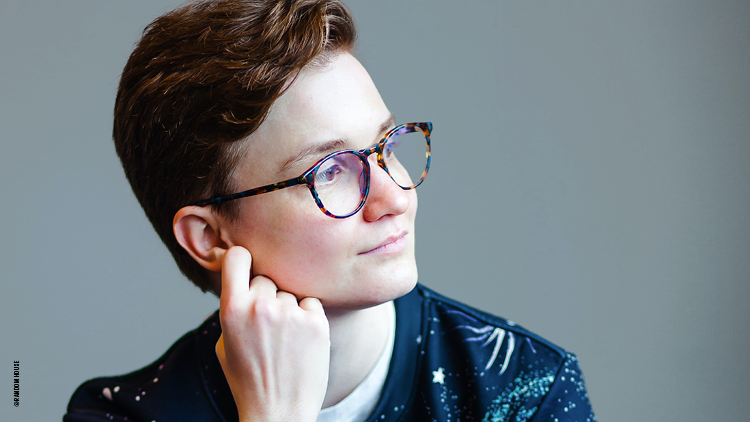How This Trans Author Came to Terms With His Acne
Author: Peyton Thomas

I never cared much about acne when the world called me a woman. Back then, I understood 10-step skin care regimens and full-coverage makeup artistry as the domain of an especially girly kind of girl. I was not her. Never would be. No, sir. I got by on drugstore basics: that ubiquitous orange Neutrogena gunk, the once-in-a-while Oxy pad reeking of rubbing alcohol. Acne largely left me alone. My aversion to makeup had to have helped — less heavy lifting for my fragile teenage pores. I didn’t set foot in a Sephora until I decided, once and for all, under a doctor’s supervision, to depart formally from womanhood. The irony is not lost on me.
The baseline treatment for transgender men is injectable testosterone. Its most common and visible effect is acne. Lots of it. Especially on the neck.
“Sometimes [my transmasc friends and I] go out to lunch,” writes my friend Daniel Lavery, “and I look around the table and realize we’re all wearing turtleneck sweaters.” No one is spared. And though it’s a fairly inconsequential side effect, it’s something doctors warn about. The Mayo Clinic lists acne as a risk of masculinizing hormone therapy, right next to some truly grave threats, like hypertension, diabetes, and pulmonary embolism.
I’m not too proud to admit that I myself spent a little over a year taking a very low dose of testosterone, in part because I feared the onslaught of acne. My transition progressed at a snail’s pace; every stranger I met during that year interpreted me, by sight, as a woman. Now, on a higher dose, with fewer zits, getting not infrequently ‘sir-ed’ and liking it, I have to wonder, Why did I ever sacrifice my own happiness to keep my skin clear?
I thought hard about that question when I first saw the cover art for my debut novel, Both Sides Now. It’s a young adult romance about a trans boy, Finch, who finds himself forced to argue against trans rights at a national debating championship. Some months ago, my editor at Penguin sent me a mock-up of the book’s cover. The trans YouTuber Miles McKenna portraying my roguish, redheaded Finch, poised nervously before a microphone. “[We’ll] Photoshop it all together to look totally smooth,” my editor promised. I hesitated.
When McKenna began taking testosterone, he developed “cystic, long-lasting, very bright red acne” all over his face, neck, and chest, he has said. As a YouTuber with, at the time, over a million subscribers, he was in the unenviable position of enduring this second puberty very publicly. He recalls seeing viral posts with hundreds of thousands of likes: a picture of his face; a caption like “Retweet this or you’ll have bad skin for 20 years.” He tried antibiotics, special diets, and “going to this aesthetician who would zap [his] face.” None of it worked. The cruel comments kept coming. “I was in this role of being a teacher and a confident role model,” he once said, “but not feeling positive and not feeling confident.”
I looked at the mock-up of my book’s cover. A constellation of acne dotted McKenna’s jawline, his neck. I did not want it Photoshopped away. But then, if I chose to keep it there, what would people think? Moral purity, in the eyes of most, goes hand in hand with physical appearance. Consider the Twitter meme that never dies, the one that goes something like: Some celebrity with their skin Botoxed, nip-tucked, and made up to poreless, glassy oblivion. Followed by a stannish caption along the lines of, “Now, this is how you look when you’re unproblematic!”
Teenagers are thus told they must vanquish their acne — not just to be seen as beautiful or desirable, but to be seen as good, period. Outside of Bo Burnham’s film Eighth Grade, I can’t recall any media portraying teenage acne in a morally neutral way. The bully with bad skin I’ve seen, and the shy dweeb whose hero’s journey involves a miraculous makeover. Rarely the sympathetic protagonist who has some zits and keeps them. And never, ever the teenage trans boy whose faceful of acne is a direct result of the steps he’s taken to live a fulfilled and honest life.
So I asked my publisher not to touch McKenna’s acne. It’s rare for an author to have this right at all; many have zero say over the content of their own book’s cover. I’ve heard horror stories. One friend of mine, who is Black and wrote a book with a Black protagonist, told me that her publisher opted to put a blond woman on its jacket. For all I knew, the design team at Penguin was already stamping out every red dot on McKenna’s face with aerial-strike precision.
I’m lucky — and grateful — that they listened to me. The cover of Both Sides Now portrays a real, human person with a sandwich-munchingly ordinary smattering of spots. I’m proud of it. It’s not exactly a revolutionary gesture, I know. But in the age of filters and Facetune, I hope it will at least be a kind of hug to any kid who sees it on a bookshelf. Any trans kid, especially. Those little red spots, along with the new hair growing on your face and the muscles thickening in your vocal cords and the monthly pain in your abdomen dissolving away — these things are your becoming. Throw your arms around them.
Peyton Thomas is a freelance journalist with bylines in Pitchfork, Billboard, and Vanity Fair. He was a 2016 Lambda Literary Fellow. Both Sides Now is his debut novel.
This story is part of The Advocate’s 2021 Film and TV issue, which is out on newsstands October 5, 2021. To get your own copy directly, support queer media and subscribe — or download yours for Amazon, Kindle, Nook, or Apple News.
Original Article on The Advocate
Author: Peyton Thomas




